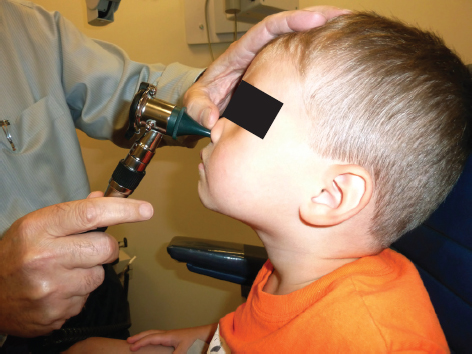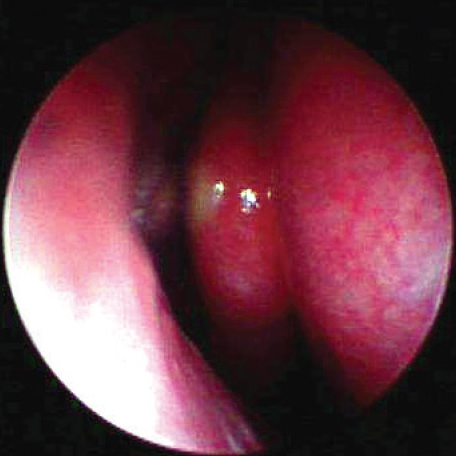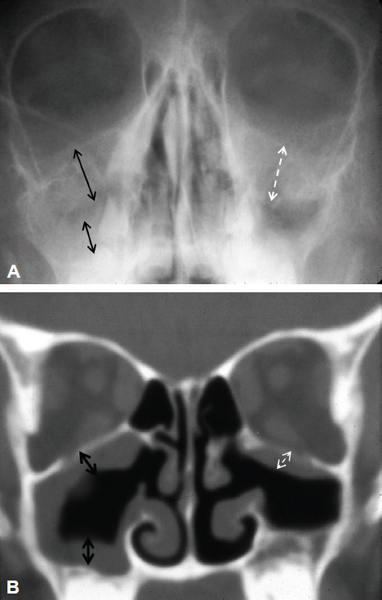18 Pediatric Sinusitis Rhinosinusitis (sinusitis) is a common but often misdiag-nosed disease in children. It is often confused with upper respiratory tract infections (URTIs), which are primarily caused by viruses. Most viral infections, 80%, will clear on their own without medical intervention. The symptoms are thought as chronic if they persist for more than 3 months. This definition, however, is based on work in adults and may or may not be appropriate for children because of their immature immune systems and the small ostia of the sinuses. For practical purposes, if the child is treated with a prolonged course of a broad-spectrum antibiotic for 20 days and once again is symptomatic within a week, the infection is likely more chronic in nature. Our understanding of sinusitis and predisposing factors continues to evolve. We know that children have an immature immune system and are susceptible to viral infections. Viruses most commonly associated with acute sinusitis are rhinovirus, parainfluenza, influenza, and adenovirus. These viral infections destroy the normal first line of defense—normal ciliary function—resulting in stasis of secretions and inflammation of the mucosa of the nose, ostia, and sinuses. Inflammation is most significant in the ostiomeatal complex where the frontal recess, maxillary, and agar nasi cells drain. This sequence of events results in inflammation and edema of the small ostia, creating an environment appropriate for invasion of bacteria normally residing in the nasal cavity. Chronic ciliary dysfunction, such as Kartagener syndrome, is associated with a very high incidence of unrelenting chronic sinusitis. Children may also be anatomically predisposed to chronic infections because the same amount of edema from an infection will have more of an occlusive effect on the small ostia of the sinuses. We do know, however, that septal deviation, paradoxical turbinates, concha bullosa, and infraorbital cells are not associated with chronic sinusitis.1,2 Allergies may also be a component of inflammation resulting in recurrent or chronic sinusitis, however, the incidence of sinusitis correlates more concisely with URTI than seasons of significant allergy. In some patients, allergies no doubt play a key role in the etiology of sinusitis. The role of food allergies is not well understood and needs further investigation. The role of gastroesophageal reflux disease (GERD) remains controversial. Barbero3 noted parallel existence between URTI and reflux and attributed GERD as a possible underlying etiology for chronic sinusitis. GERD could certainly cause inflammation of adenoid and nasal mucosa and interrupt normal ciliary function exposing the mucosa to bacterial colonization. This could in turn be associated with bacterial sinusitis. Objective evidence of this relationship however has not been confirmed. Children with immune deficiencies are unquestionably prone to recurrent and chronic sinusitis and should always be considered as a possible underlying etiology. The bacteriology of chronic sinusitis continues to evolve because of the pressures of antibiotic therapy. Investigations of acute sinusitis found that Streptococcus pneumoniae was the most common organism (30%), followed closely by Moraxella catarrhalis and Haemophilus influenzae (20%). H. influenzae is usually nontypable. Both M. catarrhalis and H. influenzae have a high incidence of b-lactamase–producing enzymes and are therefore resistant to many antibiotics. Bacteria of chronic sinusitis is very similar, however, Brooks4 notes a higher incidence of bacteroides and other anaerobes. Resistant strains of H. influenzae,5 S. pneumoniae serotype 19A,6 methicillin-resistant Streptococcus aureus (MRSA),7,8 have markedly increased. Since the introduction of the pneumococcal vaccinations (PCV7), there has been an eradication of S. pneumoniae from the adenoids with a shift to more resistant strains of H. influenzae.9 Traditionally, nasal congestion, purulent rhinorrhea, headache, irritability, and both daytime and nighttime cough have been followed as indicators of chronic sinusitis. Most pediatric otolaryngologists would be hesitant to diagnose chronic sinusitis without cough as a component. Nighttime cough as a sole symptom would suggest reflux as a cause of cough and not sinusitis. Daytime coughing with nasal congestion and rhinorrhea is highly suggestive of sinus infection and duration of symptoms is a clue to chronicity. Asthmatics appear particularly sensitive to increasing cough with concurrent sinusitis. Older children are able to articulate where the pain or headache is located. If there is unrelenting pain in the vertex or back of the skull, this is highly suggestive of sphenoid sinusitis and computed tomography (CT) scan should be obtained to rule this out. Younger children cannot articulate where they hurt, and irritability is the primary manifestation of the pain. None of these symptoms however have been validated as a measure of severity of sinusitis. About 78% of the American Society of Pediatric Otolaryngology (ASPO) members are not using validated tools for assessing the outcomes.10 Wald differentiates routine sinusitis from more serious sinusitis by noting a high temperature of 103°C rectally and purulent rhinorrhea.11 The author argues that routine acute sinusitis will clear on its own and does not require antibiotic therapy while more severe sinusitis is associated with higher temperatures and will require antibiotics. Children are sometimes a challenge to examine. There is one thing the author has learned over the years; if a child does not want you to look into their nose—you are not going to look in their nose! The author always starts with examination of the ears. If there is a good cooperation then there will be a reasonable chance at looking at the nose. It is recommended to start with an otoscope that is gently inserted into the nose, in a slow nonthreatening manner, bracing the otoscope on the thumb, which is used to slightly rotate the tip of the nose (Fig. 18.1). The examiner’s fingertips can also gently extend or flex the head. The author cannot emphasize enough that a slow, nonthreatening approach to the child is the key to a successful examination. Once looking through the otoscope, identify the inferior turbinate and extend the head just a little to identify the middle turbinate. Once the middle turbinate is identified, look laterally to see if the middle meatus can be seen. Purulence can usually be noted if there is a sinus infection (Fig. 18.2). It is an unusual child who will tolerate a rigid endoscopy, and it is usually not attempted in the clinic. A flexible scope can be used to examine the middle meatus and adenoid pad in many children. Adequate anesthesia of the nose can be accomplished within a few minutes with a 1:1 mixture of Afrin (oxymetazoline nasal) and 4% lidocaine (lidocaine hydrochloride) sprayed one to two times. Visualization of the sinuses is beneficial in assessing a child for chronic sinusitis. Several modalities have been recommended. Transillumination in a child is virtually worthless. It only assesses the maxillary sinus, and from the child’s perspective, nothing good can be happening in a dark room with a doctor. Plain films are only good for assessing the maxillary sinuses, and inaccurate when compared with CT scans (Fig. 18.3).12,13 A CT scan is clearly the gold standard for assessment of the sinuses. It is not without risk, however, and should not be obtained indiscriminately. Younger children will require sedation or a general anesthetic. There is increasing concern regarding radiation exposure in children. Brenner et al14 raised concern regarding radiation and increased risk of cancer later in life. This article was highly controversial but sparked further evaluation of how much radiation children were actually getting. Rogers15 noted that children were getting doses of radiation similar to adults, and because they had smaller heads were actually getting larger doses of radiation. This is of particular concern as 25 to 30% of a child’s bone marrow is located in the skull.16 Pediatric radiologists are now acutely aware of the hazards of radiation and practice “as low as reasonably achievable,” doses to obtain the desired results. Imaging of the sinuses to “prove” sinusitis is not necessary, but frequently performed by primary care physicians. If there is purulence in the nose then the sinuses are going to be involved. The author does not recommend obtaining a CT scan unless the Otolaryngologist and parents agree that endoscopic sinus surgery is warranted. Obtaining the CT scan with a protocol for reformatting in the coronal plain can be saved and used for guided imaging in case it is wanted intraoperatively. The primary reason for obtaining a CT scan is to look for anatomical abnormalities, which would increase the risks of surgical intervention and document the extent of ethmoid disease. Magnetic resonance imaging of the sinuses are not of much help unless there is concern about extension of disease into the orbit or cranial cavity. Figure 18.1 Hand position during nasal examination of the nose with an otoscope. Figure 18.2 Examination of the middle meatus with an otoscope after surgery. Image as seen through the otoscope. The initial work-up is variable depending on the symptoms, duration, and age of the patient. If there are recurrent ear infections and purulence over the adenoid pad, an adenoidectomy performed as an initial step is quite feasible. If there are persistent symptoms, more aggressive medical management and evaluation for underlying systemic problems such as allergies, immune deficiencies, GERD, cystic fibrosis, and ciliary dyskinesia are warranted. The order and expertise of the physicians required for these evaluations have to be individualized according to the patient’s symptoms and expertise available. It is reasonable to perform allergy and immune screening before CT scanning or endoscopic sinus surgery.
Etiology
Signs and Symptoms
Physical Examination
Work-Up
Medical Management
Stay updated, free articles. Join our Telegram channel

Full access? Get Clinical Tree





